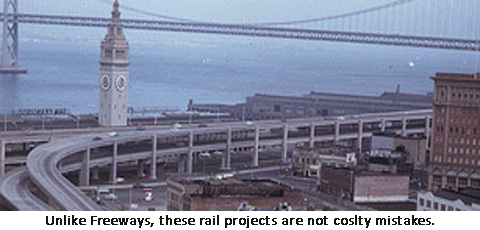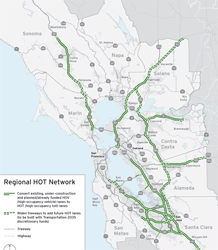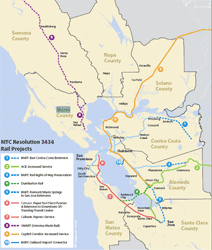 Rail projects are expensive. Take, for example, the San Francisco Bay Area: Despite the fact that BART is having budget difficulties they moving ahead with a $500 million 3.2-mile Oakland Airport connector, a $3.4 billion rail car fleet replacement and a $6 billion extension to Silicon Valley. MUNI, which is also in the midst of a budget crisis, is moving ahead with $1.58 billion 1.7-mile surface/subway expansion program. It should be no surprise then that the amount general outrage directed at this apparent disparity between these ‘elitist’ projects and the service cuts faced by the same agencies seeking these glamorous expansions is growing.
Rail projects are expensive. Take, for example, the San Francisco Bay Area: Despite the fact that BART is having budget difficulties they moving ahead with a $500 million 3.2-mile Oakland Airport connector, a $3.4 billion rail car fleet replacement and a $6 billion extension to Silicon Valley. MUNI, which is also in the midst of a budget crisis, is moving ahead with $1.58 billion 1.7-mile surface/subway expansion program. It should be no surprise then that the amount general outrage directed at this apparent disparity between these ‘elitist’ projects and the service cuts faced by the same agencies seeking these glamorous expansions is growing.
What is lacking in this debate however is that these rail projects have lower operating costs than the services they are meant to replace. For example BART has one of the highest fair box recovery ratios of transit system in the country! Furthermore these projects increase transit capacity, speed and reliability and thus are able to entice more people to switch modes.

These projects also make a statement – they’re massive monuments to transportation. They’re immovable and permanent. This is important because people who are willing to give up their car need some reassurance that transit is there for them. Switching modes is perhaps one of the hardest and most life altering changes that a person can make; the automobile is almost an extension of a person. To give up one’s car, for many people, is to give up a part of oneself – a part of one’s identity. That void needs to be filled, and a bumpy, impermanent bus route just won’t do it – not even if you label it BRT.
 Now, I know that there are people out there outraged that I am concerned about people who have cars when there are people out there who barely have access to, or who may no longer be able to afford the bus. There is no excuse for the transit services to be cut, especially when ridership is at such high levels and global warming is peaking its’ ugly head. Everyone should be outraged by this! However, the solution is not to attack the projects that put transit on the right track for the future. These projects will allow buses to be replaced by trains that cost less to operate and simultaneously allow for increased reliability and capacity. These projects are the way forward. We should support them.
Now, I know that there are people out there outraged that I am concerned about people who have cars when there are people out there who barely have access to, or who may no longer be able to afford the bus. There is no excuse for the transit services to be cut, especially when ridership is at such high levels and global warming is peaking its’ ugly head. Everyone should be outraged by this! However, the solution is not to attack the projects that put transit on the right track for the future. These projects will allow buses to be replaced by trains that cost less to operate and simultaneously allow for increased reliability and capacity. These projects are the way forward. We should support them.

IMAGE CREDIT: BART; BART; Flickr by ‘Will aims to rage’ and ‘pbo31’; Charles Cushman
 Following the lead of transit agencies around the country the San Francisco Municipal Transit Agency (SFMTA), the agency that operates Muni, will raise fares by fifty cents and cut some services beginning July 1st. The new fare will be $2 and there will also be an increase in the price of a Fast Pass, the transit agency’s monthly pass. Like other transit agencies around the country the SFMTA is faced with falling government subsidies in the wake of the economic crisis and needs to increase fares to cover operating costs.
Following the lead of transit agencies around the country the San Francisco Municipal Transit Agency (SFMTA), the agency that operates Muni, will raise fares by fifty cents and cut some services beginning July 1st. The new fare will be $2 and there will also be an increase in the price of a Fast Pass, the transit agency’s monthly pass. Like other transit agencies around the country the SFMTA is faced with falling government subsidies in the wake of the economic crisis and needs to increase fares to cover operating costs.
